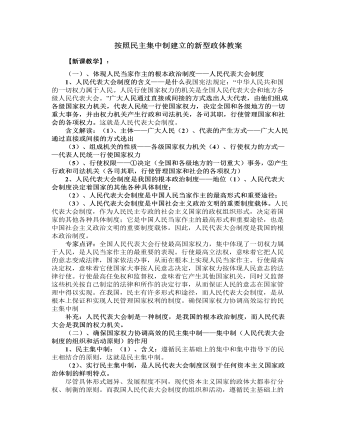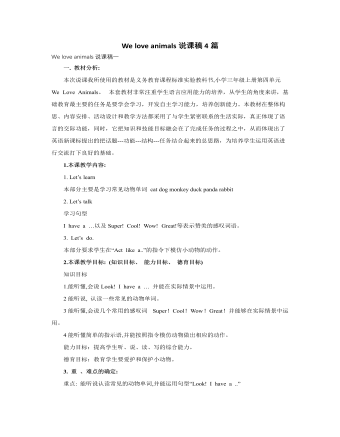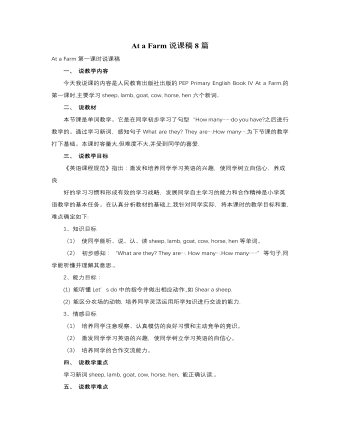-

人教版新目标初中英语八年级下册It’s a nice day, isn’t it教案2篇
"Hello! Welcome to English class! Introduce yourself. Meet your new classmates." That's what the teacher says. What do you say? "Oh no!" It can be difficult talking to new people. But it can be fun, and you can make friends. How do you do it? Make small talk. Small talk is polite conversation. "Wang Nan is a great pingpang player, isn't she?" "I'd love to meet her, wouldn't you?" "It's been raining a lot, hasn't it?" Tag questions are a form of polite speech. To make small talk successfully, you should know how to make them. You should also know what topics to talk about. Try to learn this unit carefully. The next time you're in English class, you'll find out. Making small talk's easy, isn't it? (“你好!欢迎你!请做一下自我介绍。认识一下你的新同学。”通常在课上老师会这样说。你会说什么呢?“噢,不!”与陌生人谈话太困难了。但是这也很有意思,并且你还能交到朋友。你该怎么做呢?闲聊。闲聊指得是礼貌的对话。“王楠是一个很棒的乒乓球运动员,不是吗?”“我希望自己能认识她,你呢?“今年的雨水很多,不是吗?”反意疑问句是一种礼貌用语。为了使得谈话成功,你应该知道怎样去进行闲聊。你还应该知道与不同的人该谈论什么样的话题。认真的学习这个单元吧,下次在英语课上,你会发现与大家展开谈话是一件很容易的事情,不信我们来试试。)

人教版新目标初中英语八年级下册How long have you been collecting shells教案2篇
Step Ⅱ Show the new words on the screen and teach the new words. Read the new words to students and ask them to repeat.Step Ⅲ 3aThis activity introduces new vocabulary and provides reading practice using the target language.In this activity first look at the four pictures.T: What can you see in the pictures?Ss: Four snow globes.T: Right. There are four snow globes in the pictures. And what are they?Ss: They are a monster, two polar bears, two penguins and a birthday cake.Write these words on the blackboard: snow globe; monster; polar bear; penguin and birthday cake. Read them to the class and ask students to repeat each one. Make sure students understand each word.Use a computer to show the E-mail message on the screen and read the message to students.Get students to read the e-mail on their own, and then draw lines connecting each snow globe and its description.Correct the answers.AnswersA line should connect each snow globe picture with the words that describe it in the letter.Step Ⅳ 3bThis activity provides writing practice using the target language.First review Activity 2a on Page 47.Then ask students to complete the message according to Activity 2a.Some partial sentences are given to students. Write about one person's collection.When students work, walk around the room checking the progress and offering help as needed.When they finish, ask some students to read their messages to the class.

人教版新目标初中英语九年级上册Teenagers should be allowed to choose their own clothes教案2篇
Step 1 Greeting Greet the class and check the homeworkStep 2 A duty report The S on duty gives a report on the rules in his home and lead in 3a “Sun Fei’s and Wu Yu’s rules” Step 3 ReadingSs read the conversation and write the two girls’ rules in the chart. Check the answers.Get Ss to read after the tape and then read aloud by themselves. Then, T explains the language points.Step 4 Pairwork 3bRole play. Use the information in chart to practice with the conversation in 3a covered. They can look at the sample conversation in the right box.Step 5 Task 2 “Who’s the best reporter?”Make a survey by asking any 5 students the questions in the chart in activity 4. Then give out a report about it. See who is the best reporter? And the best reporter will get a nice ball-pen.Step 6 Summary and homework:Write out the report in your exercise-books.Period ThreeStep 1 Greeting and a duty reportThe S gives a duty report talking about his experience of being late for school. Lead in the question “Do you ever get to school late? How often do you get to school late? Always, usually, sometimes, or never?Step 2 1a Get Ss to finish writing.Step 3 Pairwork 1b Get Ss to talk about their answers with their partners using the sample conversation in the box on the right.Step 4 Listening practice2a Lead-in: What will happen if you get to school late? What about Peter? Let’s listen to a conversation between Peter and his father. Get Ss to finish 2a (As usual, for the first time, Ss only listen.) Check the answers.

人教版新目标初中英语九年级上册I like music that I can dance to教案
教学目标: 1. Express preferences2. Talk about one’s likes and dislikes and the reasons3. Learn to express one’s opinions 4. Learn to write a reply 语言功能: 1) Talk about one’s preferences, using t he relative clause2) Talk about people’s likes and dislikes and the reasons3) Talk about opinions语言结构: Relative clauses with that and who语言目标:What kind of music do you like?I like music that I can sing along with.I love singers who write their own music.We prefer music that has great lyric.重点词汇及短语:heart, photography, interest, class, whatever, miss, okay, expect, sweet, taste, itself, laboratory, cancer, increase, biscuit, main, care, prefer… to…, remind somebody of …, dance to, sing along with, be sure to, interest somebody, make somebody adj., to be honest, suit somebody, on display, catch up教学重难点:What do other people think of the different kinds of things? How to express one’s opinions? 学习方式:讨论,合作学习情感目标:通过本单元的学习,能提高学生的艺术鉴赏能力和审美情趣,并引导学生养成健康的饮食习惯。课时安排5课时第一课时:Section A: 1a-2c第二课时:Section A : 3a-4第三课时:Section B:1-2c, Self check2第四课时:Section B: 3a-4, Self check1第五课时:Self check ReadingI like music that I can dance to.

人教版新目标初中英语九年级上册How do you study for a test教案2篇
内容提示本单元主要内容是学会利用verb十by/with gerund表示方式方法来讨论学习英语的策略,认识自己在学习方面的长处和不足。初步了解现在完成时的结构和用法。现在完成时由助动词have/has+动词的过去分词构成,主要表示过去发生的某一动作对现在仍有影响或造成的后果,常与already,yet,just,ever,never等副词连用。教学目标一、学习目标(Language Goal) 1. Talk about how to study . 学会讨论各种学习方法和策略。2. Find out your suitable learning methods. 找出适合自己的学习方法。 二、语言结构(Language Structures) 1. Verb + by with gerund by+动名词短语 表示“通过…途径,方法” 2. How questions have引导的特殊疑问句 三、目标语言(Target Language) 1. How do you study for tests ? 你是怎样准备考试的?Well , I study by working with my classmates. 哦,我和同学们一起学习。2. Have you ever studied with a group ? 你曾经参加过学习小组吗?Yes , I have . I’ve learned a lot that way . 是的,参加过。通过这种方式我学了许多。

人教版新目标初中英语九年级上册It must belong to Carla教案
一、Section A该部分有4个模块。第一模块围绕Whose volleyball is this? 这一话题展开思维( 1a)、听力(1b)、口语( 1c)训练;第二模块围绕上一模块中的话题进行听力( 2a-2b)、口语训练( 2c);第三模块继续围绕前两个模块中的“making inferences”展开训练。训练形式为阅读排序( 3a)和两人问答(3b);第四模块仍就上一话题展开讨论。二、Section B该部分有4个模块。第一模块要求根据图画和所提供的单词写出合理的句子;第二模块在听力( 2a-2b)和分角色口语训练( 2c)的基础上,继续进行“推测”训练; 第三模块围绕“Strange events in Bell Tower neighborhood”这一话题展开阅读( 3a)和写作(3b -3c)训练;第四模块以dream为话题展开小组活动。三、Self Check该部分有3个模块。第一模块以填空形式对所学词汇进行训练;第二模块就8个谚语展开阅读和讨论。

人教版新目标初中英语九年级上册Where would you like to visit教案2篇
The First PeriodⅠ.Teaching Aims and DemandsKnowledge Objects(1) Key Vocabularytiring, educational, fascinating, thrilling, peaceful, exotic, trek, jungle, take it easy, explore, historic, site(2) Target LanguageWhere would you like to go on vacation?I’d like to trek through the jungle, because I like exciting vacations.2. Ability Objects(1)Train students to talk about places they would like to visit with the target language.(2)Train students to describe vacations with different adjectives.(3)Train students' listening skill.3. Moral Object,It′s more interesting to go on vacating somewhere instead of staying at home.Ⅱ. Teaching Key Points1. Key Vocabularytiring, educational, fascinating, thrilling, peaceful, exotic, trek, jungle, take it easy, explore, historic, site2. Target LanguageTalk about different places with the target language.Ⅲ. Teaching Difficult Points1. Describe vacations with different adjectives.2. Talk about different places with the target language.Ⅳ. Teaching Methods1. Teaching by illumination2. Teaching by doing chain drills3. Teaching by pairworkⅤ. Teaching Aids1. A tape recorder2. Some pictures of different places with famous views

人教版新目标初中英语九年级下册Rainy days make me sad教案
1. 教材分析本单元以how do things affect you?为话题, 从颜色、天气、音乐、广告、产品等方面谈论了外界事物如何影响人的心情。要求学生掌握表达某物或某事给人带来的感觉、看法或影响等。共设计了四个部分的内容:Section A 该部分有4个模块:第一模块围绕Which restaurant would you like to go to?这一话题展开思维(1a)、听力(1b)、口语(1c)训练;第二模块围绕How does music affect you? 进行听力(2a-2b)、口语训练(2c);第三模块继续围绕how do colors in the restaurant affect you这一话题展开训练,训练形式为阅读和问题体验(3a)和小组活动(3b);第四模块仍就How do things affect you这一话题以调查的形式展开讨论。Section B该部分有4个模块:第一模块围绕产品广告对人们的影响这一话题以“配对”(1a)与“列举”(1b)两种形式展开训练;第二模块继续围绕How do things affect you? 进行听力(2a-2b)、口语对话训练(2c);第三模块围绕“Advertising”这一话题展开阅读(3a-3b)和写作(3c)训练;第四模块围绕How posters affect you这一话题以口语训练形式展开小组活动。

人教版新目标初中英语九年级下册You’re supposed to shake hands教案
教学目标:1. 掌握本单元一些重点词汇的写法和用法。2. 学会自如谈论餐桌礼仪。Step 1 RevisionAsk some students to retell the customs at the table in France in the passage in 3a.Step 2 Self checkPart 1. Fill in each bland with the correct word given. Students do the exercises by themselves at first. Then check the answers. Ask the students to comprehend the sentences and help them point out uses of some words, like “arrive (at / in) sw., spend time / money on sth , spend time / money (in) doing sth.”Part 2. Read about Fan Ling’s experience in a western restaurant. Understand the passage. Point out some key points in the passage.1. be / get used to doing sth. 习惯做某事2. begin with = start with 以….开头3. crowd v. 挤满,塞满 the crowd 人群 crowded adj. 拥挤的Then students discuss about how she would solve her problem. Ask some to share their stories with others.Part 3. Complete the crossword by looking at the sentences on the left. Then check the answers.

人教版新目标初中英语八年级上册How do you get to school教案2篇
Step Ⅶ Role play ( Work on 1b)1. First ask two students to read the dialogue to the class.Sa: How do you get to school?Sb: Well, I ride my bike to the subway station. Then I take the subway.2. Now work with a partner.Suppose you use two kinds of transportation to get to school \Hangzhou\Beijing... (bus, train, subway, walking, bike, etc.) Tell how you get there. You may use the phrases in 1a.3. Then ask different pairs of students to present their conversations to the class.Step ⅧListening1. Work on 2a(1) First ask students to read the list of information that Thomas wants to know.…where Nina lives.…how far from school she lives.…how long it takes to get to school.…how she gets to school.…what she thinks of the transportation.(2) Tell students what transportation and bus stop mean.bus stop 汽车站 transportation n. 运送;运输Then tell students we'll hear a recording. Please put a checkmark in front of each thing that Thomas wants to know.(3) Now play the recording for students.( Have students pay attention to the sample answer.) (4) Then correct the answers.

人教版新目标初中英语八年级下册He said I was hard-working教案2篇
This activity introduces some new vocabulary and provide oral practice using the target language.Task 1 . Ask four students to stand in front of the class, and the teacher asks them the following questions as a reporter.1.What are you going to do when you grow up?2.What are you going to do next week?3.What are going to do after school?The students will give different answers, then ask a good student to report what they said.I am going to e a doctor.What did she say?----------She said she was going to be a doctor.I am going to have a party on Friday night.What did he say?-------He said he was going to have a party on Friday night.I am going to do my homework.What did she say ?------ She said she was going to do her homework.I am going home after school.What did she say?-----She said she was going home after school.Say In this unit we are going to learn to use words like to report what someone said.Task 2. Read the instructions. Then ask a student to read the four questions. And write the words on the Bb. Explain what soap opera is.Task 3. Ask the students to Look at the pictures, point out the TV screens in the picture. Ask one girl to read what Marcia said.What did Marcia say? She said She said she was having a surprise party for Lana on Friday night. Repeat the other pictures in the same way.Activity3. Listen and number the pictures in activity 1a.

人教版新目标初中英语八年级下册Why don’t you get her a scarf教案
教师带领学生复习有关描述宠物的词汇,采用教师提问学生回答的方进行。如:T:What animals do you think would be good pets?What animals do you think would be bad pets?What do you think are good animals for a six-year-old child?然后学生进行 pairwork 练习。Task two: 师生互动,学习探究 1、播放3a部分的录音,引导学生一边听录音,一边跟读。2、通过听录音学生回答以下问题:Why do you think pot-bellied pigs are popular?What are the advantages and disadvantages of keeping such a pet?教师对学生的回答进行及时点评。3.学习范文,学习重点短语,为下步的模仿写作提供语言素材。T :1. )Have you ever kept a pig as a pet?Do you like pigs? St.:No.…Why don’t you like to keep a pig? St: No.They’re too dirty and lazy(Do you know in some foreign countries like Hollyland, Australia,pigs are the most popular pet.there’s a kind of pig.(图)it has an interesting name? it ‘s called a pot-bellied pig.) Now,let’s learn an article about this kind of interesting pet.2.)play the tapeSt.:Listen and repeat3.)show some Qs on computer(本子St.: read silently,then answerthe Qs(本子)4.)Ask ss. Close book and retell this passage.(what is a pot-bellied pig? Is it a good or bad pet? ) St.: retell it to each other“A pot –bellied pig is a popular pet now…”5.read the article together.St.:.practice reading

人教版高中政治选修3按照民主集中制建立的新型政体教案
◇本框题小结:◇3个体现:即人民代表大会制度是我国的根本政治制度的3个体现(1)、人民代表大会制度决定着国家的其他各种具体制度;(2)、人民代表大会制度是中国人民当家作主的最高形式和重要途径;(3)、人民代表大会制度是中国社会主义政治文明的重要制度载体。◇3个表现:即民主集中制确保国家权力协调高效的表现:(1)、从人民代表大会和人民的关系来看①各级人民代表受选民和原选举单位的监督,选民或选举单位有权罢免自己选举出的代表;②各级人民代表大会代表人民统一行使国家权力(2)、从人民代表大会与其他国家机关的关系来看①其他国家机关都由人民代表大会产生,对它负责、受它监督;②在人民代表大会统一行使国家权力的前提下,其他国家机关依照法定分工依法行使各自的职权。(3)、从中央和地方的关系来看①地方必须服从中央;②在保证中央统一领导的同时,必须考虑地方特殊利益,充分发挥地方的主动性和积极性。

人教版新课标PEP小学英语三年级上册We love animals说课稿4篇
能力目标:培养学生听,做,说,读,写的能力,增进身体各部分的协调能力,语言表达能力。情感目标:让学生通过运用语言来完成学习任务,感受成功,从而引发和培养学生学习英语的内在动机,最终使他们形成英语学习的积极态度。同时培养学生要爱护动物。2. 教学重难点本课的教学重点是让学生能听、说、认读六个有关动物的词汇。教学难点是学生能将这六个有关动物的词汇运用到简单的英语句子中表达,突破重点和难点的关键是结合低年级学生喜欢游戏的特点,通过玩游戏,使单调的知识溶进生动的活动之中,让学生在听,做,动的过程中,掌握知识,并灵活地运用。三.说教法1.教法设计为了顺利完成以上教学目标,更好地突出重点,突破难点,按照学生的认识规律,我采用了讲读、直观演示、愉快教学相结合的方法,层层递进,激发学生的学习兴趣,充分调动他们学习的积极性,保持他们强烈的好奇心和旺盛的求知欲,进而促使他们由兴趣发展到产生要学好它的志趣。

人教版新课标PEP小学英语三年级上册Look at Me说课稿4篇
5. 文化目标:本单元的文化知识是西方的万圣节(10月31日),万圣节是西方孩子们最喜欢的节日之一。他们身穿不同的戏装,戴上千奇百怪的面具,在街区走来走去。不少孩子手中还提着一盏“杰克灯”(Jack-o’-lantern)/南瓜灯,这种灯的做法是先把南瓜挖空,在南瓜上挖出眼睛、嘴和鼻子,贴上蓝色纸,制成南瓜灯,当中点上一支小蜡烛,放出幽灵似的蓝白光。孩子们常常从一家走到另一家,在人家门前高喊:“你想挨捉弄,还是款待我们?”(Trick or treat!)如果主人不给糖果或零钱,这些孩子就会捉弄他(她)。他们有时在门把手上涂上肥皂,有时把人家的猫涂上颜色。这些恶作剧常令大人啼笑皆非。当然,大多数人家都非常乐意款待这些天真的小客人。在晚上,人们常举行晚会,孩子和大人都身穿不同服装。万圣节人们常常做一些传统的游戏和活动,像:试图摘悬挂的苹果,算命,听有关鬼的故事。学校也经常举行晚会或化装游行。

人教版新课标PEP小学英语三年级下册How many说课稿7篇
我随意走动,观察学生们用英语交流的情况,有困难的适时指导一下。学生们在完成任务的过程中,积极运用语言,激发了学习兴趣,同时还实现了与数学学科的渗透和联系。在这节课的最后,我布置了一个有层次的作业,让学生自主选择:①听录音,仿读会话;②分角色表演会话;③改编会话,分角色表演并录成磁带。分层次的作业,让不同程度的学生都能有事可做,都有表现自己的机会,体验到成功的喜悦,同时使学生的语言交际向课外延伸,使他们能带着动力,保持兴趣继续学习。总之,在这节课的教学设计中,我重视对新知识的铺垫和自然导入,通过多种方式的呈现,让学生们自然而然地学习新知识。充分利用游戏、合作交流等教学手段,让学生们饶有兴趣地操练语言、运用语言,在完成任务过程中巩固知识,运用知识,体验成功的喜悦,培育积极的学习情感,形成良好的学习策略,并将这些积极的因素带人下一步的学习当中。

人教版新课标PEP小学英语三年级下册Welcome back to school说课稿4篇
2、学生小组间的问答:“Where are you from?”“I’m from…”(根据孩子自己制作的头饰回答)3、请几个小组开火车问答:“Where are you from?”4、教师出示钟表(把时间调到下午):“Good afternoon!”教师带上Mr. Black的头饰(走到一位学生面前)说:“Good afternoon! My name’s Mr. Black. I ’m from China.”孩子根据自己的情况回答:“Good afternoon, Mr. Black. I’m Xiao Dong . I’m from China.”教师提问一组孩子。然后请学生到前面来扮演Mr. Black.5、教师带着Mr. Black 的头饰走到台前,说:“I have a friend in our class. Do you know who’s she?”教师指着扮演Amy的同学说: “This is my friend Amy.”(引导全班孩子问好)Ss: Nice to meet you.A: Nice to meet you, too!Ss: Where are you from?A: I’m from America.Ss: Welcome!6、教师播放Let’s talk部分的课件, 学生观看对话。跟读、模仿,分角色给课件配音。7、小组分角色练习对话。8、小组表演对话。趣味操练 (Practice)1、Listen and order the cards: 将课文图片打乱顺序,让孩子听一听, 摆一摆。2、表演Let’s talk部分的对话。

人教版新课标PEP小学英语四年级上册My Home说课稿9篇
1、教师出示Let’s learn的课件(教材配套),提问“What can you see in the picture?”鼓励学生们积极发言,尽量说。2、学生会说到TV. table. chair desk甚至bed 等词。如果学生说出本课的生词,教师要特别鼓励,并反复的读几遍,加深学生的印象。如果学生指着table说成了desk, 教师可通过图片对比两个单词的不同。3、针对学生第2项说的情况进行生词的学习:教师图片出示phone等图,教学生一一学说生词,每个生词示范读后,都请大部分学生试读。注意phone的尾音。4、教师播放课件,学生跟读学习。5、游戏:将本课时的单词上下左右贴在黑板上,播放录音,学生听一听,指一指。再次打乱图片顺序,学生根据录音指图片。教师还可请能力强的学生说单词,其他学生指图片。6、让学生听录音,跟读Let’s learn中生词。然后教师随意说词,学生快速的指出。

人教版新课标PEP小学英语四年级下册At a Farm说课稿8篇
一、说教材《At a Farm》是义务教育课程标准实验教科书英语(PEP)四年级下册的内容。本课要求在理解课文的基础上掌握五个动物的单词“cat, rabbit, pig, duck, dog”和两个句子“Are they ducks? No, they aren’t.”本节课是四年级下册第六单元第三课时。本单元重点学习农场上常见的牲畜和蔬菜名称以及包含名词复数的一般疑问句,而学生在学习了前两课时之后,排除了句型上的困难,而且这五个单词在以前的学习中也见到过,所以要把单词和句型的规范书写放在首位,打牢基础,还要培养学生在理解课文基础上朗读课文的能力。我确定了三个教学目标。1、能够听、说、读、写“cat, rabbit, duck, pig, dog”这五个动物单词以及句子“Are they ducks? No, they aren’t.”2、能够理解并试唱Let’s chant部分的歌谣。3、能够总结五个元音字母的发间规律。重点:掌握五个动物名词以及句型的拼写。难点:准确朗读课文和五个元音字母的发音规律。

人教版新课标PEP小学英语四年级下册It’s Warm Today说课稿10篇
活动三:猜猜天气,真实对话。本课重难点是问句Can I wear my____?句型的自然运用,如何让学生开口去问这个问题,真实情境的创设可化解这一难题。我设计了一个根据提示猜天气的游戏,由生与温度计的互动进行操作,在学生猜的过程中教授句型Can I wear my____?避免了机械式的句型问答操练,调动学生说的积极性。活动四:再编儿歌,整合句型在问句与答句教授完后,朗朗上口的儿歌让学生对新授句型有一个整体的感知,并加深句型理解,为最后学生语言的输出作好准备。活动五:自然承接,理解运用。在学生对Can I wear my____? Yes, you can. No ,you can’t.句型有了初步的感知之后,再去引导学生给别人的穿着提出建议You can wear____.并出示不同特征天气的图片让学生进一步操练,在理解运用中简单带过这一句型。3、搭建语言框架,演绎语篇创设情景,充分挖掘教材中未呈现的内容,以地图为主线,以任务为驱动,充分开展小组合作学习。